CAA News Today
Communing with Dore Ashton
posted by CAA — April 28, 2017
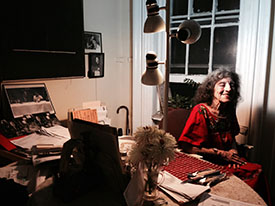
Dore Ashton at the kitchen table in her home on East Eleventh Street, New York, New York, 2011 (photograph © Madeline Djerejian)
“Communing with Dore Ashton” by Michael Corris has just been published at the open-access Art Journal Open. Corris, an artist and author based in Dallas, writes that Ashton, who died on January 30, was “one of the most energetic, widely published, and politicized American writers on art, and one of the chief proponents of the artists of the New York School (she decried the label Abstract Expressionism).” In addition to Corris’s personal memories of Ashton and their friendship, the project includes the audio and transcribed text of their 2011 conversation about Ashton’s experiences in New York art world during the 1950s and 1960s. Also included is a 2015 film by the artist Alfredo Jaar, Dore Ashton, you know, which features Ashton speaking candidly about her life, writing career, politics, and relationships with artists and writers, among them Harold Rosenberg, Philip Guston, and Louise Bourgeois. Recent photographs by Madeline Djerejian and Polly Bradford-Corris portray Ashton in her working and living spaces in New York City and Springs, Long Island.
CAA Seeks Ad Sales Rep
posted by admin — March 08, 2017
Part-time and commission based
The College Art Association (CAA), a membership and advocacy organization for those working in the visual arts, seeks a part-time advertising sales rep with media sales experience in both print and digital platforms. The ideal candidate should have established contacts in the arts and culture publishing landscape and in the wider culture field. She/he will have the mindset to strategically target prospective clients to build relationships that support CAA’s prestigious publications and events with a strong ad sales program.
The advertising sales rep would work primarily on CAA’s two flagship print journals, The Art Bulletin and Art Journal, with some work on CAA’s digital reviews platform, caa.reviews. Additional work would include selling ads for the graduate program directories and the CAA Annual Conference. Candidates for the position should have experience in billing clients, advertising proposal creation, and proper tracking of invoices and payments.
This is a part-time, commissioned-based position. The position reports to the Director of Communications and Marketing.
DUTIES AND RESPONSIBILITIES
- Manage relationships with current advertising clients and develop strategy for new client growth
- Work closely with staff across all departments to create client strategy aligned with journals, website content, and programs
- Produce client contracts for ad sales
- Oversee invoicing and record keeping for ad sales on journals and relevant websites
- Report and present on ad sales program and results to staff members and constituents
- Work with publications department staff and in-house graphic designer on ad placement and design as needed
- Other duties as assigned or requested
QUALIFICATIONS
- At least 2 years of ad sales or comparable experience
- A warm and welcoming personality that encourages relationship building
- Established relationships with advertisers and companies in the arts and culture field
- Proven track record of closing new business and maintaining current business
- Exceptional written/verbal communication skills
- Ability to work independently, organize multiple concurrent tasks, work efficiently, and follow through on details
- Experience with spreadsheets, systems, and database management and generally accepted programs and office equipment required
- BS/BA degree or equivalent preferred
Send resume and cover letter to nobourn@collegeart.org with the subject line “CAA Ad Sales Rep.”
This job description is intended as a summary of the primary responsibilities of and qualifications for this position. The job description is not intended as inclusive of all duties an individual in this position might be asked to perform or of all qualifications that may be required either now or in the future.
The College Art Association is an equal opportunity employer and considers all candidates for employment regardless of race, color, sex, age, national origin, creed, disability, marital status, sexual orientation, gender expression, or political affiliation.
CAA Seeks Ad Sales Rep
posted by CAA — March 08, 2017
Part-time and commission based
The College Art Association (CAA), a membership and advocacy organization for those working in the visual arts, seeks a part-time advertising sales rep with media sales experience in both print and digital platforms. The ideal candidate should have established contacts in the arts and culture publishing landscape and in the wider culture field. She/he will have the mindset to strategically target prospective clients to build relationships that support CAA’s prestigious publications and events with a strong ad sales program.
The advertising sales rep would work primarily on CAA’s two flagship print journals, The Art Bulletin and Art Journal, with some work on CAA’s digital reviews platform, caa.reviews. Additional work would include selling ads for the graduate program directories and the CAA Annual Conference. Candidates for the position should have experience in billing clients, advertising proposal creation, and proper tracking of invoices and payments.
This is a part-time, commissioned-based position. The position reports to the Director of Communications and Marketing.
DUTIES AND RESPONSIBILITIES
- Manage relationships with current advertising clients and develop strategy for new client growth
- Work closely with staff across all departments to create client strategy aligned with journals, website content, and programs
- Produce client contracts for ad sales
- Oversee invoicing and record keeping for ad sales on journals and relevant websites
- Report and present on ad sales program and results to staff members and constituents
- Work with publications department staff and in-house graphic designer on ad placement and design as needed
- Other duties as assigned or requested
QUALIFICATIONS
- At least 2 years of ad sales or comparable experience
- A warm and welcoming personality that encourages relationship building
- Established relationships with advertisers and companies in the arts and culture field
- Proven track record of closing new business and maintaining current business
- Exceptional written/verbal communication skills
- Ability to work independently, organize multiple concurrent tasks, work efficiently, and follow through on details
- Experience with spreadsheets, systems, and database management and generally accepted programs and office equipment required
- BS/BA degree or equivalent preferred
Send resume and cover letter to nobourn@collegeart.org with the subject line “CAA Ad Sales Rep.”
This job description is intended as a summary of the primary responsibilities of and qualifications for this position. The job description is not intended as inclusive of all duties an individual in this position might be asked to perform or of all qualifications that may be required either now or in the future.
The College Art Association is an equal opportunity employer and considers all candidates for employment regardless of race, color, sex, age, national origin, creed, disability, marital status, sexual orientation, gender expression, or political affiliation.
Art Journal Editorial Board Seeks New Member
posted by admin — January 24, 2017
CAA invites nominations and self-nominations for one individual to serve on the Art Journal Editorial Board for a four-year term: July 1, 2017–June 30, 2021. Candidates may be artists, art historians, art critics, art educators, curators, or other art professionals; institutional affiliation is not required. Art Journal, published quarterly by CAA, is devoted to twentieth- and twenty-first-century art and visual culture.
The editorial board advises the Art Journal editor-in-chief and assists her or him in seeking authors, articles, artists’ projects, and other content for the journal; performs peer review and recommends peer reviewers; guides its editorial program and may propose new initiatives for it; and may support fundraising efforts on the journal’s behalf. Members also assist the editor-in-chief to keep abreast of trends and issues in the field by attending and reporting on sessions at the CAA Annual Conference and other academic conferences, symposia, and other events in their fields.
The Art Journal Editorial Board meets three times a year, with meetings in the spring and fall plus one at the CAA Annual Conference in February. The spring and fall meetings are currently held by teleconference, but at a later date CAA may reimburse members for travel and lodging expenses for New York meetings in accordance with its travel policy. Members pay travel and lodging expenses to attend the conference in February. Members of all editorial boards volunteer their services to CAA without compensation.
Candidates must be current CAA members in good standing and should not be serving on the editorial board of a competitive journal or on another CAA editorial board or committee. Members may not publish their own work in the journal during the term of service. CAA encourages applications from colleagues who will contribute to the diversity of perspectives on the Art Journal Editorial Board and who will engage actively with conversations about the discipline’s engagements with differences of culture, religion, nationality, race, gender, sexuality, and access. Nominators should ascertain their nominee’s willingness to serve before submitting a name; self-nominations are also welcome. Please send a letter describing your interest in and qualifications for appointment, a CV, and your contact information to: Chair, Art Journal Editorial Board, College Art Association, 50 Broadway, 21st Floor, New York, NY 10004; or email the documents or inquiries to Joe Hannan, CAA editorial director. Deadline: April 17, 2017.
Art Journal Seeks Editor-in-Chief
posted by admin — January 24, 2017
The Art Journal Editorial Board invites nominations and self-nominations for the position of editor-in-chief for the term July 1, 2018–June 30, 2021 (with service on the Art Journal Editorial Board in 2017–18 as editor designate, and in 2021–22 as past editor). Art Journal, published quarterly by CAA, is devoted to twentieth- and twenty-first-century art and visual culture.
Working with the editorial board, the editor-in-chief is responsible for the content and character of the journal. He or she solicits content, reads all submitted manuscripts, sends submissions to peer reviewers, and provides guidance to authors concerning the form and content of submissions; develops projects; makes final decisions regarding content; and may support fundraising efforts on the journal’s behalf. A candidate may be an artist, art historian, art critic, art educator, curator, or other art professional. The editor-in-chief works closely with CAA’s New York staff.
The editor-in-chief attends the three meetings each year of the Art Journal Editorial Board— held in the spring and fall by teleconference or in New York, and in February at the CAA Annual Conference—and submits an annual report to CAA’s Board of Directors. CAA may reimburse the editor for travel and lodging expenses for spring and fall New York meetings in accordance with its travel policy, but the editor pays his or her own expenses for the Annual Conference.
The position usually requires one-half of an editor’s working time. CAA provides financial compensation for course release, usually to an editor’s employer.
Candidates must be current CAA members in good standing and should not be serving on the editorial board of a competitive journal or on another CAA editorial board or committee. CAA encourages applications from colleagues who will contribute to the diversity of perspectives on the Art Journal Editorial Board and who will engage actively with conversations about the discipline’s engagements with differences of culture, religion, nationality, race, gender, sexuality, and access. Nominators should ascertain their nominee’s willingness to serve before submitting a name; self-nominations are also welcome. A CV, a letter of interest from the nominee, and at least one letter of recommendation must accompany each nomination. Please mail to: Art Journal Editor-in-Chief Search, College Art Association, 50 Broadway, 21st Floor, New York, NY 10004; or email the documents or inquiries to Joe Hannan, CAA editorial director. Deadline: April 3, 2017. Finalists will be interviewed on the afternoon of May 4, in New York.
Art Journal: Winter 2016 Issue
posted by CAA — December 26, 2016
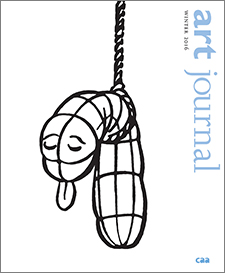 Rolando del Fico, last seen in 1970s Italian gay underground comics, is resurrected in the Winter 2016 issue of Art Journal. A project by the Catalan artist Francesc Ruiz revives the irrepressible character, picaresque hero of myriad amorous adventures, in a visual tribute replete with Rolando’s thought-bubble iconography of salamis and cherubs in various states of excitement.
Rolando del Fico, last seen in 1970s Italian gay underground comics, is resurrected in the Winter 2016 issue of Art Journal. A project by the Catalan artist Francesc Ruiz revives the irrepressible character, picaresque hero of myriad amorous adventures, in a visual tribute replete with Rolando’s thought-bubble iconography of salamis and cherubs in various states of excitement.
Other features in the issue explore little-examined aspects of more familiar bodies of work. Amy DaPonte analyzes the portraits of Turkish immigrants central to the early work of the German photographer Claudia Höfer. Liz Linden investigates the overlooked presence of the textual in the works Douglas Crimp gathered in 1977 for the watershed exhibition Pictures.
In the Reviews section, Lauren Richman reviews two exhibitions of work by the midcentury American photographer Lee Miller, along with their catalogues. The artist Liam Gillick considers a book by Dave Beech that grapples with the relation between art and capitalism in the contemporary neoliberal moment. Christa Noel Robbins assesses David J. Getsy’s book that sees the sculpture of the 1960s through the lens of transgender and “transformable” bodies. Finally, Kent Minturn reviews Pierre Leguillon’s book on the experimental typography of Jean Dubuffet—a significant compendium of the work that is also a work of art history.
CAA sends print copies of Art Journal to all institutional members and to those individuals who choose to receive the journal as a benefit of membership. The digital version at Taylor & Francis Online is currently available to all CAA individual members regardless of their print subscription choice.
New Content on Art Journal Open
posted by CAA — November 03, 2016
Art Journal Open has recently published new content. Below are the introductory sentences of an essay, an annotated bibliography, and an artist’s project.
Kate Costello
Artist Kate Costello has created a unique animation of her limited edition book, P&P, for Art Journal Open. Costello has taken P&P—which can be read as a compendium of process images (sketches, notes)—full circle by animating and translating the analogue process of paging through the book into a digital form. This project also includes an excerpt from “The Space of the Image” by curator Rita Gonzalez, and an introduction by Art Journal Open’s web editor, Gloria Sutton. Read the full article on Art Journal Open.
Penelope Vlassopoulou
Penelope Vlassopoulou began her Metamorphosis series in her home city of Athens. The series evolved in multidisciplinary dialogue with diverse urban environments including Berlin, Belgrade, and Chicago. In March 2015, Metamorphosis returned to its point of origin with no water tracing a link between Greece’s historical past and the country’s current predicament. Read the full article on Art Journal Open.
Elizabeth Mangini
“Solitary/Solidary: Mario Merz’s Autonomous Artist”
In 1968, while demonstrating students occupied university buildings less than a mile away, the Italian artist Mario Merz hung a handful of neon lights bent into the numerals 1, 1, 2, 3, and 5 above the kitchen stove in his home on Via Santa Giulia in Turin. It wasn’t yet an artwork, just something to think about in the place where he and his wife, fellow artist Marisa Merz, gathered to talk with each other and with friends. Read the full article on Art Journal Open.
Roger F. Malina
“Art-Science: An Annotated Bibliography”
We are witnessing a resurgence of creative and scholarly work that seeks to bridge science and engineering with the arts, design, and the humanities. These practices connect both the arts and sciences, hence the term art-science, and the arts and the engineering sciences and technology, hence the term “art and technology.” Read the full article on Art Journal Open.
Art Journal Seeks Web Editor
posted by Christopher Howard — November 01, 2016
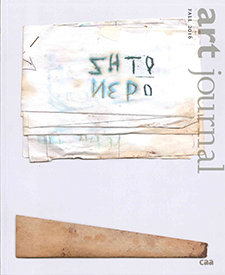 The Art Journal Editorial Board invites nominations and self-nominations for the position of web editor for the term of July 1, 2017–June 30, 2020. A candidate may be an artist, art historian, critic, educator, curator, or other art professional; institutional affiliation is not required. Art Journal Open is an independently edited companion of the quarterly Art Journal; it is likewise devoted to twentieth- and twenty-first-century art and visual culture. Content is published on a continual, rolling basis.
The Art Journal Editorial Board invites nominations and self-nominations for the position of web editor for the term of July 1, 2017–June 30, 2020. A candidate may be an artist, art historian, critic, educator, curator, or other art professional; institutional affiliation is not required. Art Journal Open is an independently edited companion of the quarterly Art Journal; it is likewise devoted to twentieth- and twenty-first-century art and visual culture. Content is published on a continual, rolling basis.
Working with the editorial board, the web editor is responsible for commissioning all content for the Art Journal Open website. He or she solicits or commissions projects, texts, images, and time-based content by artists and other authors, and determines the appropriate scope and format of each project. In consultation with the editor-in-chief and editorial board, the web editor determines which pieces should undergo peer review and subsequent revision before acceptance for publication. The web editor also works with authors and a CAA staff editor on the development and preparation of materials for publication. The editorial board expects that a major portion of the website projects will be by artists or geared to the concerns of artists and that the web editor will endeavor to give voice to under-represented perspectives. Qualifications for the position include a broad knowledge of current art, the ability to work closely with artists in a wide variety of practices, and experience in developing content for an arts website. The three-year term includes membership on the Art Journal Editorial Board and an annual honorarium, paid quarterly.
The web editor attends the three meetings each year of the Art Journal Editorial Board—held by teleconference or in New York in the spring and fall, and at the CAA Annual Conference in February—and submits an annual report to CAA’s Board of Directors.
Candidates must be current CAA members and should not serve concurrently on the editorial board of a competitive journal or on another CAA editorial board or committee. The web editor may not publish her or his own work in the journal or on the website during the term of service. Nominators should ascertain a nominee’s willingness to serve before submitting a name; self-nominations are also welcome. Please send a letter describing your interest in and qualifications for the position, a CV, and at least one letter of recommendation to: Art Journal Web Editor Search, College Art Association, 50 Broadway, 21st Floor, New York, NY 10004; or email the documents to Joe Hannan, CAA editorial director. Deadline: January 9, 2017; finalists will be interviewed on February 15 in New York or via Skype.
New and Forthcoming in CAA’s Journals
posted by CAA — September 12, 2016
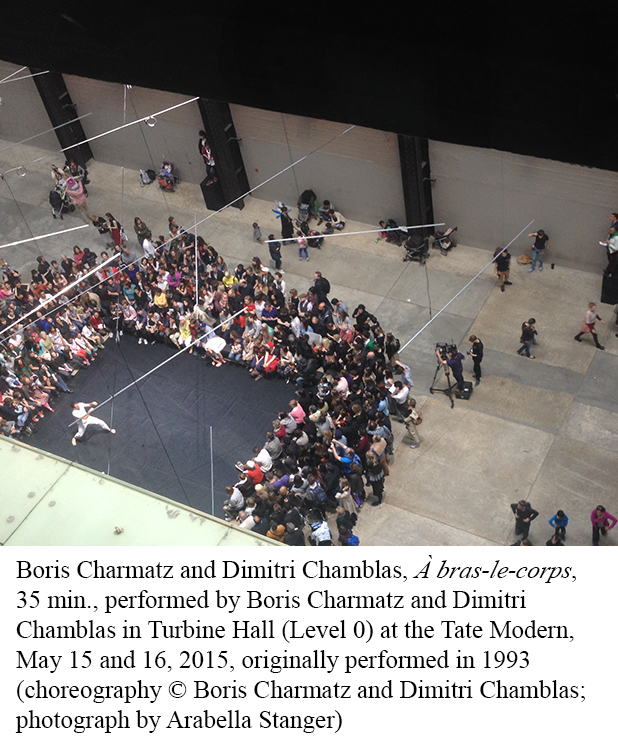 caa.reviews
caa.reviews
Boris Charmatz’s If Tate Modern Was Musée de la Danse? (May 15–16, 2015) is the focus of a new multimedia review on the Scalar platform, If caa.reviews were performance.reviews?. Organized by Juliet Bellow, the project includes an introduction by Bellow, and three reviews of the performances at the Tate Modern by Arabella Stanger, Nicole Zee, and Tamara Tomic-Vajagic. The review presents the complexities of Charmatz’s transformation of the Tate Modern into a museum of dance for two days and features an interactive map showing where the performances occurred in the Tate Modern, in addition to videos and still images. Charmatz’s project challenges conceptions of museums as institutional spaces and incorporates audience participation and “unauthorized” performances. This review is part of a new caa.reviews initiative to review time-based media works.
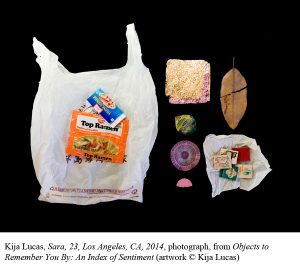 Art Journal Open
Art Journal Open
Art Journal Open this summer launched a new cluster of conversations featuring artist residencies, with artists who have participated in residencies interviewed by those who organize these programs. Through the conversations, Art Journal Open examines how residencies operate logistically and conceptually, and how they contribute to creative production. Conversations published in the series include Caitlin Masley-Chalet of Guttenberg Arts (Guttenberg, NJ) with artist Diana Shpungin, Vanessa Kauffman of Headlands Center for the Arts (Sausalito, CA) with artist Patricia Fernández Carcedo, and Amy Cancelmo of Root Division (San Francisco, CA) with artist Kija Lucas.
Earlier this summer, Art Journal Open published the third of a three-part series on appropriation as an artistic strategy: “Knight’s Heritage: Karl Haendel and the Legacy of Appropriation, Episode Three, 2013” by Natilee Harren, with a response by Nate Harrison. Recent features also include a review of Wetware: Art, Agency, Animation (Beall Center for Art + Technology, University of California, Irvine, February 6–May 7, 2016) by Charissa Terranova, and “Humans Have Been Human for So Long,” a dialogue between artist Shana Lutker and curator Mika Yoshitake on Lutker’s exhibition Shana Lutker: Le “NEW” Monocle, Chapters 1–3 at the Hirshhorn Museum and Sculpture Garden in Washington, DC (October 27, 2015–February 16, 2016).
Art Journal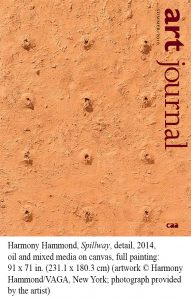
The forthcoming Fall 2016 Art Journal features a project by the artist Penelope Vlassopoulou, whose source material is the phrases and drawings carved in underground cells by detainees during the Nazi occupation of Greece. In other feature articles, Mario Merz’s fascination with the Fibonacci series is the cruz of Elizabeth Mangini’s examination of works created within the intellectual and political ferment of 1960s Italy, and Emily Hage rethinks Romare Bearden’s historical and political position in relation to the dense collages he made for the covers of Time and Fortune. The Reviews section includes Eve Meltzer’s account of the film Eva Hesse and reviews of books by Thomas Crow, Claire Robins, and Joan Kee. An annotated bibliography by Roger F. Malina, the astrophysicist who also serves as executive editor of Leonardo Publications/MIT Press, explores the highly productive intersections of art and science.
Recently published in the Summer 2016 Art Journal is a project by the renowned artist Harmony Hammond. The covers of the journal were given a waxy coating to convey the nature of her intensely tactile paintings and prints, featured in a twenty-page portfolio. In the features, Amanda Jane Graham takes a close look at the interweaving of domestic and performing spaces in Trisha Brown’s 1975 dance Locus; Mechtild Widrich investigates the effects on the urban fabric of the new/old National Gallery of Singapore, created from a colonial-era court building; and Dan Adler traces the idea of an all-pervasive Apparatus in 1980s and 1990s works by the German photographer Thomas Ruff. The Reviews section begins with Chris Taylor’s examination of the film Troublemakers: The Story of Land Art. Other reviews examine a new book by Chika Okeke-Agulu and the exhibition and catalogue Hippie Modernism. An annotated bibliography by Audra Wolowiec explores the poetics of sound and language.
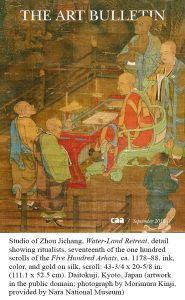 The Art Bulletin
The Art Bulletin
The cover of the September 2016 issue of The Art Bulletin depicts Buddhist monks evoking ghosts in a nocturnal ceremony; the large detail from a polychrome silk scroll accompanies Phillip E. Bloom’s essay on twelfth-century Chinese paintings of Buddhist rituals. In other essays featured in the September issue, Judy Sund reconsiders nineteenth-century perceptions of Watteau’s Pierrot character as forlorn, Christine I. Ho contextualizes a brush-and-ink painting created by a collective in the early People’s Republic of China, and James Nisbet surveys intersections of global politics and imaging in the site-specific art of Walter De Maria. In his “Whither Art History?” essay, Bárbaro Martínez-Ruiz explores Kongo visual and cultural practices in contemporary art.
The Reviews section, with a theme of “Urban Images, Memories, and Fragments,” includes four reviews of recent books on the cultures of fifth-century BCE Athens, seven Dutch cities from 1200 to 1700, early modern Rome, and Mexico City in light of Aztec civilization.
Taylor & Francis Online
In addition to their print subscription(s), CAA members receive online access to current and back issues of Art Journal and The Art Bulletin. Taylor & Francis, CAA’s publishing partner, also provides complimentary online access to Word and Image, Digital Creativity, and Public Art Dialogue for CAA members. To access these journals, please log into your account at collegeart.org and click the link to the CAA Online Publications Platform on Taylor & Francis Online.
A Tactile Art Journal
posted by Christopher Howard — July 25, 2016
 The Summer 2016 issue of Art Journal must be touched to be believed—though there is plenty to enjoy visually as well. For a project by the renowned artist Harmony Hammond, the covers of the journal have been given a waxy coating to help convey the nature of her intensely tactile paintings and prints, featured in a twenty-page portfolio of images. In an accompanying text, Hammond relates the impact on her work of a 2001 censorship incident in San Francisco.
The Summer 2016 issue of Art Journal must be touched to be believed—though there is plenty to enjoy visually as well. For a project by the renowned artist Harmony Hammond, the covers of the journal have been given a waxy coating to help convey the nature of her intensely tactile paintings and prints, featured in a twenty-page portfolio of images. In an accompanying text, Hammond relates the impact on her work of a 2001 censorship incident in San Francisco.
In essays in the journal, Amanda Jane Graham takes a close look at the interweaving of domestic and performing spaces in Trisha Brown’s 1975 dance Locus; Mechtild Widrich explores the effects on the urban fabric of the new-old National Gallery of Singapore, created from a colonial-era court building; and Dan Adler traces the idea of an all-pervasive Apparatus in 1980s and 1990s works by the German photographer Thomas Ruff.
In the Reviews section, Chris Taylor examines James Crump’s film Troublemakers: The Story of Land Art; Joseph L. Underwood reviews Chika Okeke-Agulu’s book Postcolonial Modernism; Charissa N. Terranova looks at the Walker Art Center exhibition and the catalogue Hippie Modernism; and an annotated bibliography by Audra Wolowiec explores the poetics of sound and language.


